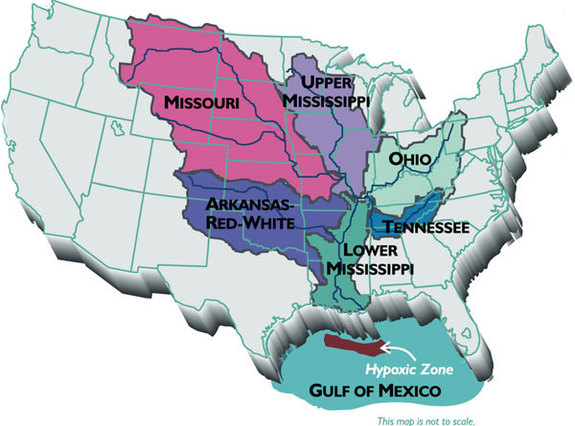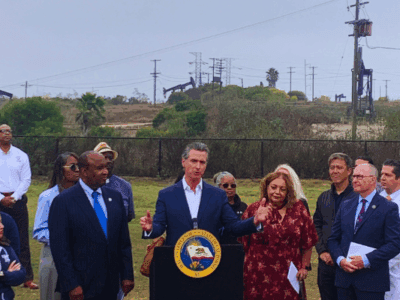Mass. v. EPA bears fruit for environmental petitioners
Court rules that EPA must decide if new water quality standars are needed to protect the Gulf of Mexico

Cross-posted at CPRBlog.
A US District Court in Louisiana recently ruled, in Gulf Restoration Network v. Jackson, that EPA must decide whether it has to impose new water quality standards for nutrient pollution in the Mississippi River watershed. Although that might seem far afield from the Supreme Court’s greenhouse gas emissions decision in Massachusetts v. EPA, in fact it’s a direct descendant.
The Administrative Procedure Act allows any interested person to petition any federal agency to make, change, or repeal regulations. The APA doesn’t specifically say how courts should review agency responses to petitions, and in general the courts have been quite deferential to petition denials.
Massachusetts v. EPA is best known for holding that states have standing in federal court to challenge actions that contribute to climate change. But it also has important implications for APA rulemaking petitions. The plaintiffs in Massachusetts v. EPA had petitioned EPA to set limits on greenhouse gas emissions from cars. EPA denied the petition on the grounds that it did not have, and in any case would not choose to exercise, authority over greenhouse gas emissions. A slim majority of the Supreme Court, after finding that plaintiffs had standing and that greenhouse gas emissions are within the scope of the Clean Air Act, went on to hold that EPA could not deny the rulemaking petition for reasons “divorced from the statutory text.” In that case, that meant that EPA had to actually make a judgment about whether greenhouse gas emissions cause or contribute to air pollution reasonably anticipated to endanger public health or welfare. That holding (and a change in presidential administration) eventually led to EPA’s endangerment finding and regulation of greenhouse gas emissions from (so far) tailpipes and large new stationary sources.
Although Gulf Restoration Network is a Clean Water Act case, it is closely analogous to Massachusetts v. EPA. The Clean Water Act relies primarily on the states to set water quality standards for water bodies within their boundaries. However, it requires that EPA “promptly prepare and publish” regulations setting its own water quality standards if it finds standards submitted by the states to be inconsistent with the Clean Water Act or it “determines that a revised or new standard is necessary to meet the requirements” of the Clean Water Act. 33 USC 1313(c)(4)(B). The groups relied on that hook — their petition argued that states within the Mississippi River watershed had failed to set numeric standards for discharge of nutrients to waterways and that as a result nutrient pollution continued essentially unabated, annually causing development of a low-oxygen “dead zone” in the Gulf of Mexico. They asked EPA to impose numeric water quality standards for nitrogen and phosphorous both within the states and for the Gulf. EPA denied the petition, explaining that it preferred to tackle the Gulf’s nutrient problem through cooperative nutrient management programs rather than rulemaking. EPA refused, however, to directly say that the water quality standards requested in the petition were not “necessary to meet the requirements” of the law. As the reviewing court explained:
EPA clarified that it was not concluding that [numeric nutrient criteria] were not necessary to meet CWA requirements but rather that EPA would exercise its discretion to continue in its partnership efforts with the states, not foreclosing its ability to resort to
federal standards at some future time should that become necessary.
That’s pretty impressive bureaucratic double-speak. It seems to say that maybe the requested standards are necessary, but EPA’s not quite ready to say so yet. Or maybe it’s saying that federal standards aren’t necessary yet, but might be in the future. In rejecting EPA’s denial, the court demanded greater clarity. EPA, it ruled, must determine whether new or revised nutrient standards are “necessary” or not. If it finds that they are necessary, it would then presumably follow that EPA must propose new standards.
The ruling doesn’t yet give plaintiffs the new water quality standards they want. The court ruled only that EPA must directly address the question of necessity. It declined to hold that the necessity evaluation must (like the endangerment decision required by Massachusetts v. EPA) be determined entirely on the basis of science. As a matter of statutory interpretation of the Clean Water Act, that strikes me as correct — the relevant question is whether the nation’s waters can be restored and maintained with the existing water quality standards or not. That’s a question that encompasses what regulatory or other options are available, on what time frame, and what responses they would bring. But the ruling is clearly a step forward for the Gulf. At the least, EPA must take a hard look at the collaborative efforts that have been underway in various forms since at least 2001. So far, those efforts have not made a lot of progress. In order to validly deny the petition, EPA would have to explain why not, and make the case that progress is now being made or that there is good reason to believe it will be made soon. Perhaps EPA must even set some real timelines for evaluating progress, and hold out the threat of imposing federal regulation at a date certain to light a fire under reluctant states.
Reader Comments
2 Replies to “Mass. v. EPA bears fruit for environmental petitioners”
Comments are closed.







I’m glad to see that ordinary people (in this case petitioners) can have an effect on improving a valuable part of our environment (to say nothing of the Gulf’s fishing industry) by getting a court to force the EPA to do a job it should’ve been doing all along; regulating the dumping of nitrates into our rivers.